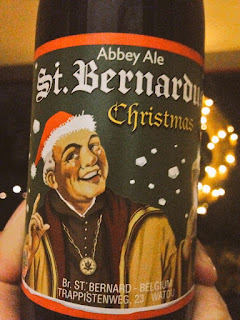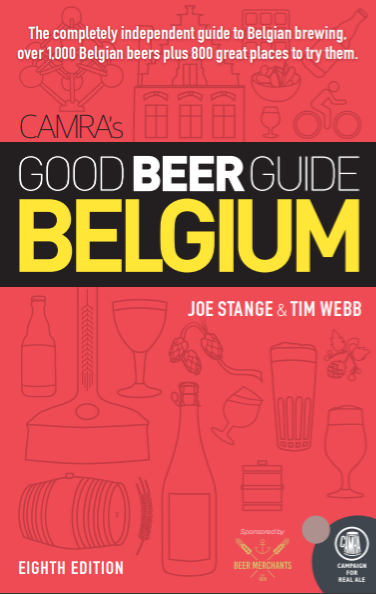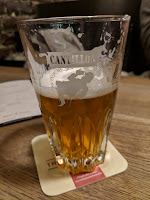 So, we're launching a podcast. Zach Johnston of UPROXX and myself. It's many months in the making, starting with a long series of those late-evening half-drunken "Wouldn't it be cool if..." talks that you don't really think will go anywhere.
So, we're launching a podcast. Zach Johnston of UPROXX and myself. It's many months in the making, starting with a long series of those late-evening half-drunken "Wouldn't it be cool if..." talks that you don't really think will go anywhere.
It's called One More Road for the Beer. Put it in your earholes as you travel home for the holidays, or on your next commute. Let us know what you think.
Each episode will focus on a different city; we're trying to keep each one to 30 or 40 minutes... We want to hit the highest of the highlights, plus a few obscurities -- the places you'd want to visit if you're on a business trip or only have a couple of days in town. And we aim to put it all in context. We want to put you in the atmosphere. We want the beer foam to tickle your nose. We want you to smell the local snacks.
In case you listen and want to look them up, here are the places we mention in the first show (and a map!):
Grand Place
Cantillon
Moeder Lambic Fontainas
Moeder Lambic Original
Poechenellekelder
Nüetnigenough
Fleur en Papier Doré
Les Brasseurs
Bier Tempel
Delhaize on Anspach
Petit Filou
We also mention beers from Cantillon, Senne, Tilquin, De Ranke, Oud Beersel, Dupont and Boon... more or less in that order.
Obviously we can only scratch the surface in each city. When possible we'll point you toward additional resources... In this case we're in my wheelhouse, and I'd humbly suggest Around Brussels in 80 Beers or the Good Beer Guide Belgium.
Notable correction: When talking about Cantillon in the 1970s, I should have said Jean-Pierre Van Roy was responsible for starting the nonprofit museum side of the operation. For some reason I just said Jean, which the name of Jean-Pierre's son who is now in charge. First-show nerves, maybe.
Next episode: Prague.
Friday, December 21, 2018
One More Road for the Beer: Brussels.
Monday, December 17, 2018
What's Up with All Those Belgian Christmas Beers, Anyway?
The Kerstbierfestival is in Essen, at Belgium's North Pole (near the Dutch border). The organizers go to great lengths to source every Belgian Christmas beer they can. Their first was in 1994, when they were able to find 38 of them. At that time there were about 110 breweries in the country.
What we can draw from this? For one, we can see that the number of special Christmas brews has expanded right alongside the number of small, independent breweries. That makes sense. It also makes sense (to me, anyway) that the existence of the festival in Essen has had something to do with it. Brewers know the event and want their beer to be a part of it.
So those are a couple of the possible answers to the question of why Christmas beers have become such a big thing in Belgium. Here are some other explanations I've heard or read at various times:
The faux-historical one: In the legendary old days the Belgian farmer-brewers would have had surplus grain after the harvest, so they would brew stronger ales to enjoy for the winter holidays. It's somewhat plausible and makes a nice story. I haven't found any evidence of it.
Palm started it: In 1947 it released Palm Dobbel, a somewhat stronger version of Palm delivered to clients as a thank you, and also to celebrate the brewery's bicentennial (based on a now dubious date shrouded in mist; in 1747 it would have been the De Hoorn farm brewery, which is older than that). Off the top of my head I can't think of any present-day Belgian holiday beers older than this one. That doesn't make it the first.
No, Artois started it: The story goes that Artois in Leuven introduced Stella as a Christmas beer named, sort of, for the Star of Bethlehem. However our friend Evan Rail has had a look at the brewing records. Trouble is, the brewery had fermentation problems with its earlier batches and didn't release the beer commercially until August 1927. From then on it was year-round. Thus I feel reasonably confident in declaring the Stella Christmas story to be nonsense. (Interestingly, the AB InBev site says it released Stella as "une bière de Noël, respectant en cela une coutume de l'époque," or "volgens de toenmalige traditie." That is, according to the custom of the time. So, maybe holiday beers really were a thing back then. Or, maybe we should be careful not to trust anything found on marketing websites, and this one in particular.)
Blame the British: Senne brewmaster Yvan De Baets -- whose Zinnebir Xmas is one of the best -- once told me his theory that the Belgians got the idea from the British, especially after World War I. This was a time when the Belgians were trying out pale ales and stouts too, so why not Christmas ales? (But as with other consumables, the Belgians have a special way of adding their own panache.) This is a rather plausible theory that also matches up somewhat with the timing of the Palm and Stella stories. If it was a "custom of the time," maybe this is why.
The capitalistic one: It's the money, stupid. You don't need to go to the Kerstbierfestival or fancy bottle shops to find Belgian Christmas beers. You can go to nearly any supermarket in Belgium and find endcap displays full of them. Or you can visit many corner cafés to find table tents and posters advertising brands like Palm Dobbel, Bush Noël, or Tongerlo Christmas, to name a few of the more common ones. They're nominally only available this one time of year, so many customers go for it. Not many brewers want to miss out on that.
More thoughts from De Baets: "As a brewer I can tell you what gets us moving, sometimes at least: We see clients, pubs, making an emphasis on Christmas beers at the end of the year and all the customers having their interest focused on them. So, what do we do? Well, we simply make one also. It maintains a interest in our products, it's as basic as that."
The truth may be some combination of all these things (er, minus the Stella bit): old traditions, good marketing sense, and a whole bunch of smaller breweries well versed in cranking out variety and oddities -- what's one more, to them? Why not join the fun?
Tuesday, October 2, 2018
Pubs of Berlin: The Strassenbahn.
How near to your home does a "local" need to be?
I don't live in one of the hipper parts of Berlin that are chock-a-block with bars. I live in a sleepy, green, leafy part of town where bars -- even smoky old Kiezkneipen* -- are far less common than retirement homes and samey, mediocre Italian restaurants. So I think anywhere within about 20 minutes' walk qualifies, to me, as a potential local. So what about a 20-minute bike ride, does that count?
I can walk to the excellent Foersters Feine Biere in about 20 minutes, and that makes me lucky. I call it my local. But at the moment it's closed for cleaning and repairs after some water damage in the summer. I wonder if the other regular punters in the neighborhood feel like I do... a bit rudderless without it. Even if I only pop in there once or twice a month, I like to know that I can.
There is another candidate not too far away: the Strassenbahn. It's been on my mind because I ride past it on the bus sometimes. A Kloster Andechs sign hangs out front, and that gets my attention. Eventually I remember to look the place up and see what it's about. Not long after, I invite a friend to meet me there, to finally go and have a look-see.
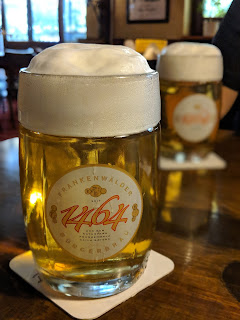 It turns out I can bike there in eight minutes, whereas the walk would be a little less than half an hour. I'm going to activate the bicycle loophole here; it increases the radius of qualification. Strassenbahn is thus eligible as a backup local, in a pinch. By definition you can only have one real local, in my view. But maybe you can have alternates.
It turns out I can bike there in eight minutes, whereas the walk would be a little less than half an hour. I'm going to activate the bicycle loophole here; it increases the radius of qualification. Strassenbahn is thus eligible as a backup local, in a pinch. By definition you can only have one real local, in my view. But maybe you can have alternates.
The Strassenbahn's name means "streetcar." It sits just outside the Ring, halfway between the Bundesplatz and Heidelberger Platz stations. The busy bridges for S-Bahn trains and car traffic are visible from the pub's shady terrace, whose venerable trees nearly dominate the intersection.
Inside is plenty of dark wood, lampshades, old signage and photos -- strong signals of Gemütlichkeit.** A chalkboard overhead lists various dinner specials, all scratch cooking, most of it in the range of €5 to €8 per plate. Traditional North German things like herring share the menu with veggie moussaka or Thai curry soup. The main front barroom is non-smoking. I gather there is a smoking room somewhere, though I never notice it.
Unusually for a place like this, there are eight taps. The favored house pils is Franconian -- from Frankenwälder Burgerbräu in Naila -- so we start with that. It's the cheapest on the menu at €2.95 a half-liter, which suggests a concerted effort to have a beer of that size under €3. It implies some combination of nostalgia and general principle. (As you can see in the photos, the beers are also beautifully poured here.) The 1464 Pils itself is pretty fine; relatively thin for its region, moderately spicy-bitter, clean. For a Franconian pils it tastes a bit Northern. You could drink a lot of it without much arm-twisting.
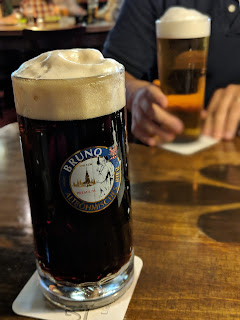 Next I go dark, to one listed on the menu as Bruno Schwarzbier. I've done my homework and already know it to be a tmavý ležák, one of those Czech-brewed dark lagers that tend to be richer and more malty than any German Schwarzbier. At 3.8% strength it is a 10-degree tmavý, which is pretty unusual in Czechia. In Germany it's legally a Schankbier. It tastes bigger: light caramelized sweetness, note of spicy licorice mingling with the roast. A lot of character but, again, very easy to drink. Later, when I think about going back to the Strassenbahn, this is the beer I think about most. That lush foam sticks in my memory too.
Next I go dark, to one listed on the menu as Bruno Schwarzbier. I've done my homework and already know it to be a tmavý ležák, one of those Czech-brewed dark lagers that tend to be richer and more malty than any German Schwarzbier. At 3.8% strength it is a 10-degree tmavý, which is pretty unusual in Czechia. In Germany it's legally a Schankbier. It tastes bigger: light caramelized sweetness, note of spicy licorice mingling with the roast. A lot of character but, again, very easy to drink. Later, when I think about going back to the Strassenbahn, this is the beer I think about most. That lush foam sticks in my memory too.
For my third and last beer I go with the one that drew my eyes here in the first place: Andechser Spezial Hell. At 5.8% strength this is no ordinary helles; it's a proper festbier. It's harvest time, you know? It pulls off that great Bavarian balancing act of sweet fulsome malt, gentle bitterness, and a finish just dry enough to keep you wanting more. Hey, some people think these beers are boring. I meet them sometimes, like this American working in Munich who says he doesn't like Bavarian beers, he only wants IPA. These people exist. I pity them.
There is another interesting thing about the Strassenbahn: It calls itself a Kneipenkollektiv -- a collectively owned pub. Six friends founded it a few weeks before I was born -- that is, a few weeks before Star Wars premiered. According to the website, they suspect that they are the oldest remaining collective in Berlin. Everybody who works there gets paid the same. Some proceeds go to charity.
No pricey pale ales here, no fruited IPAs, no selection of 100 bottled beers. Just a handful of well-brewed and perfectly poured lagers at fair prices. This is why I scratch my head when I visit Stone and see something like Mahrs U going for €6.50 per half-liter. Because it's robbery, that's why. There is no need to pay that much for a good lager if you're willing to look around town a bit, and visit some local institutions.
* Neighborhood bars, including Eckkneipen -- corner bars. Important Berlin institutions.
** Coziness.
Wednesday, July 25, 2018
Bastogne, and Beer.
My memory of the Bastogne Historical Center before it was refurbished is probably unfair. I remember it as a dusty collection of wartime junk and an old-timey fake news reel or two to put you in the mood. Surely there was more to it than that. My clearest memory is an old bottle of Fort Pitt Pilsner that would have been some GI's beer ration.
The center reopened, after a much needed refurbishment, in March 2014 as the Bastogne War Museum. Focusing (naturally) on the Battle of the Bulge, it immediately became one of Belgium's most enthralling history museums.
The audioguide is obligatory, and it does most of the work. As you walk around to various exhibits, reading to your heart's content, the earphones tell a story that switches between four different perspectives -- four characters who were "there." Besides the obligatory American paratrooper there is a Nazi German officer, a local school boy, and a young teacher who has collaborated with the Resistance. Video screens stationed around the museum add depth, replaying interviews with locals as well as German and American veterans who remember. The interviews themselves are a treasure.
The story reaches an emotional climax when the characters' stories intersect in a recreated Bastogne estaminet -- or rather, in its cellar. The seats for museum visitors are wooden café chairs with tables; all that's missing is a cool glass of beer (though there are plenty of opportunities for that in Bastogne afterward). Old-fashioned signs for Orval hang on the walls, though I doubt they're period-accurate. No harm done, since Orval's style is timeless.
Other beer artifacts spotted in the collection: a small printed world atlas for British soldiers, provided by Bass and with its familiar logo on the front; a large German beer bottle whose molded letters are hard to read, but appears to be from a brewery in Koblenz; and those familiar old bottles of Fort Pitt.
About that beer ration: I'm sure it was welcome, but perhaps not the godsend we might imagine -- not for soldiers in the European theater, anyway. Anecdotally, US troops had a taste for stronger stuff and found plenty of it in France, Belgium, the Netherlands and Germany -- cellars and shops full of wine, cognac, schnapps. At times the locals shared it freely; more often it was simply taken. One of the surprising things -- or perhaps not so surprising, all things considered -- about World War II anecdotes from US soldiers is how often they were drunk.
Outside the museum, a "screaming eagle" sculpture honors the 101st Airborne, donated by the "city and citizens of Bastogne." It appears poised to drink from a helmet -- based on the story of a paratrooper who comforted his wounded buddy by filling his own helmet with beer (twice) from a local tavern.
In recent years a sweet, strong brown ale named Airborne, brewed at Bouillon, has taken over the cafés of Bastogne. The deal is you drink it from a ceramic beer helmet -- the sort of gimmickry at which Belgium excels. The beer itself is no showstopper but it doesn't need to be. Think of all the old-timers who come and give it a go -- plenty of American tourists visit Bastogne, for obvious reasons, and they still include a few veterans.
They're unlikely to forget the experience.
Sunday, July 22, 2018
A Few Cruise Beers I Liked, and a Little About Them.
 Somehow I only tasted eight of the 45 beers poured on Friday's Craft Beer Cruise, which kicked off the fourth annual Berlin Beer Week.
Somehow I only tasted eight of the 45 beers poured on Friday's Craft Beer Cruise, which kicked off the fourth annual Berlin Beer Week.
My relatively low tally may have had something to do with the perfect weather, best enjoyed on the top deck while watching Berlin's bustling riverbanks scroll slowly past. It looked like the whole city had come out to enjoy the sun and drink beer. ("Hey, you're drinking beer over there on that boat! Us too! WHOO!") Meanwhile the taps were all below decks. It surely also had something to do with the conversation. And the fact that I went back for seconds of a few that I really liked.
What beers I liked best, and a little about them:
Fürst Wiaçek Nimble: Session-strength cloudy hop nectar brewed in collaboration with Lervig of Norway, at 3.8% abv. Its tropical character reminded me of piña colada, with pineapple and coconut notes, making me wonder if it had those new Sabro hops (it didn't). Meanwhile it was clean, bitterish, dryish, and perfectly balanced. One of the very few "New England-style" ales I've had where I'd want multiple pints. It's proper Berlin-brewed too, as Fürst Wiaçek are now full-timers at the new CraftZentrum contract brewery in Spandau.
Schneider Weisse Tap X, Mein Nelson Sauvin: I don't need to say much about this one, because the Nelson Sauvin smelled and tasted muted -- nearly undetectable. (Tasting a couple of hop-bombs first thrashed our thresholds.) Which meant that it tasted basically like soft, gentle, sweet, strong Aventinus. So, world class. I also love the fact that the organizers have no qualms about embracing 146-year-old G.Schneider & Sohn aboard the craft boat. That's how it ought to work.
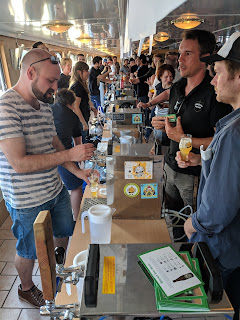 Heidenpeters/Hops & Barley Intense Pulse Lupulin: This amply hopped IPL was the only lager on the boat, and also one of the best beers on it (probably). Bitter and moderately dank rather than fruity. I look forward to getting to know it better over the next couple of months, when it's sure to keep appearing around town (as did the past couple of official BBW beers). Maybe it could've used more bitter-bite to balance the inevitable softness from so much dry-hopping. But then I'm nit-picking.
Heidenpeters/Hops & Barley Intense Pulse Lupulin: This amply hopped IPL was the only lager on the boat, and also one of the best beers on it (probably). Bitter and moderately dank rather than fruity. I look forward to getting to know it better over the next couple of months, when it's sure to keep appearing around town (as did the past couple of official BBW beers). Maybe it could've used more bitter-bite to balance the inevitable softness from so much dry-hopping. But then I'm nit-picking.
Kemker Elisabeth Farmhouse Ale: I'd never heard of them, and trying random saisons tends to be a masochistic exercise. So I was pleasantly surprised. I found distinct lemon-lime character from the hops (which I now see are Mittelfrüh) and grain (wheat and raw spelt). Because of that lemony grain taste I guessed wheat, but I didn't know. Moderately bitter, with a light tangy acidic impression, grassy and dry -- yeah, I could drink a lot of this. Turns out it's 4.5% abv too, very useful strength.
Kemker is a new firm based near Münster, in wee Alverskirchen. I don't know (yet) where this brew was actually made. In their garage, for all I know. I'm asking. Meanwhile they appear to be running a successful crowdfunding campaign to move their nanobrewery to a nearby farm. Could be a name to watch.
Friday, July 20, 2018
A Floating Fest on the Spree, and Its Variety Beers.
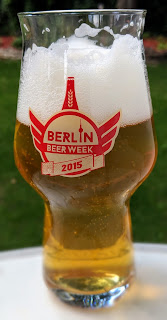 Berlin Beer Week launches this evening at 7 p.m. local time. That's when a passenger boat carrying about 330 people pushes off into the Spree for a three-hour floating beer festival.
Berlin Beer Week launches this evening at 7 p.m. local time. That's when a passenger boat carrying about 330 people pushes off into the Spree for a three-hour floating beer festival.
The sold-out Craft Beer Cruise is the first event among more than 70 -- see the full list here -- planned for the Week's fourth year. It concludes July 28 with a big bash at Stone Berlin.
Cruise tickets sell out months in advance, snapped up by those in the know almost as soon as they are released.* Some of these folks work on the local beer scene in one way or another; many more are the fellow geeks and enthusiasts one tends to see at bars around town -- familiar faces. (Though I like to think there must be a few tourists with uncanny foresight.)
Berlin's beer scene is insular but friendly -- but I reckon most city's beer scenes are the same in that respect. That's what makes them "scenes" after all: like-minded folks gravitating toward something they enjoy. So if the scene is clubby, it's certainly not unwelcoming. That's a biased take from someone who often writes about these folks and their beers and bars.
The cruise features 44 beers from 44 different brewers (not counting several collaborations), plus the official Berlin Beer Week beer -- a "double dry-hopped India pale lager" called Intense Pulse Lupulin, brewed by Heindenpeters and Hops & Barley. Overall the list leans local with a good smattering of others from Germany and abroad. So each participating brewer (or firm) chooses one beer to send -- a presumably special beer, for a special event.
It may be instructive to break down the numbers, for a skewed snapshot of a Berlin-based variety-beer hootenanny.
Of those 44 beers, based on their own descriptions:
- Sixteen are some form of "IPA," plus one IPL. How do those IPA's break down? Three are "sour." Three are "New England," plus one "Mango Milkshake." Three are "double" or "triple." Three are "session." So there is variety, sort of.
- Fourteen appear to have been brewed with fruit, plus one cider. (Reinheitsgebot, schmeinheitsgebot.) Other ingredients include hemp, chamomile, Earl Grey tea, and black salt.
- Ten use the words "sour" or "wild."
- Four are billed as "DDH" or double dry-hopped, including the official BBW beer. Double dry-hopping is not new and it's weird that people make a thing of it now, but hey, people like adjectives.
- Speaking of the BBW beer, the India pale lager... that's the only lager on the entire list.
- There are four Berliner(-style) weisse beers, though only one of those (Berliner Berg's new cherried Kirsch Weisse) is actually brewed in Berlin.
- There are three Goses, two of them fruited. One is Dutch, another Hungarian, and the third is Berlin-brewed in collaboration with a Russian brewery. No doubt the brewers, over their kettles, bowed in the direction of Leipzig.
- Berliner Weiße Gipfel, at Brauhaus Lemke, tomorrow (July 21) from 14:00-21:00. A celebration of Berliner weisse, and a quasi-annual event that has helped spur a local revival of interest. (But are the locals actually drinking the stuff? That's a different story.) The €20 admission includes wonderfully geeky talks and as much low-pH beer as your tummy can handle.
- Hof ten Dormaal meet the brewer, at Bierlinie, July 26 from 16.00-20.00. I always enjoy talking to the Janssens. They are free with their opinions and genuinely enjoy what they're doing. Also I could drink their undersung Saison pretty much all day.
- Cantillon tap takeover, at the Muted Horn, July 27 from 15.00. Self-explanatory. You know, on second thought, don't go to this. I'm sure it won't be any fun. Everybody stay away.
* Disclosure: I have a press ticket for the cruise, as I write for a couple of local magazines (WHERE Berlin and Bier, Bars & Brauer) and previously wrote about Berlin Beer Week for DRAFT.
Friday, April 27, 2018
Loudness and LagerQuestTM.
The bar is loud. There are gigantic TVs everywhere, the beer is tongue-numblingly cold with no foam of which to speak, and everyone is so gregariously friendly that it creeps me out at first, but it's OK because I can't hear them anyway. The bar is loud.
Must be back in America. I try to savor the surrealism of it while I can, before the reverse culture shock wears off, my accent returns, and it starts to feel normal again. Y'all.
Amid the overwhelming variety, or at least the illusion of it, it helps me to have a mission. Narrow things down, stay on the path, and out of trouble. So, I am on American LagerQuestTM. Now that I am completely spoiled by German and Czech lager, it's time to start tasting this American "craft lager" trend that y'all (gasp) keep talking and writing about.
Here is where I remind you that although I have been writing for American beer mags for more than 10 years, I have not lived in the U.S. for 12. In some ways my American beer-drinking brain remains stuck in the year 2006, and I like it that way. Perspective! So I get to marvel at all the marvelousness -- Voodoo Ranger IPA on an American Airlines flight! -- and also feel all smug and superior about things like the great travesty that is approximately 92.4% of American-brewed saison.
First go at LagerQuestTM last night, with the beer to help jet-lagged guy get a proper night's sleep, was underwhelming. Hotel bar has one called Tennessee Lager, so I had to, didn't I? From a brewery called Hap & Harry's, with a label/tap handle meant to evoke Jack Daniels and some measure of state pride. It tasted more bitter than its teeny IBUs thanks to ice-coldness and CO2 (read: fizzy). As such, it went down rather easily -- so, did its job. The malt sweetness was plain and understated. A bland beer but not badly done. But why pay extra when you could have a longneck domestic?
I promise not to judge America or even Tennessee by this one beer, painting with a broad and hugely unfair brush. I'll need to drink at least two more beers before I start doing that.
Friday, April 6, 2018
When and How German Beer Gardens Fall Short.
It's early April, a wonderful and frustrating time to be a beer garden enthusiast in Germany. Spring has sprung, the sun has too, and as the warmth grows so does our thirst. We need to get out there. Our kids need things to climb and room to run; our skins need Vitamin D; we need beer and laughs in the out of doors.
It's a great feeling -- to work all day or all week then go into the warm sun for cool beers with friends, while our kids run rampant in a place where such things are encouraged. The Biergärten are the best things for thirsty families. They kill a lot of birds with one cool, shady stone. Their existence is absolutely one of the highlights of living here.
But they are not perfect. Rather than get all rhapsodic it's far more interesting, as usual, to get cranky and talk about the bad stuff. There are drawbacks. Maybe they will help you to feel a little bit better about that place in the city you like to go that charges and arm and a leg for imported beer and is full of twentysomethings who give your kids the hairy eyeball for daring to be in the presence of fermented beverages.
1. We all wish they'd open sooner.
The first problem is, they don't officially open until the first weekend of May -- or thereabouts. So right now is when the flipping of calendar pages seems to slow down or even reverse, like the watched clock in the classroom that ticks backwards (Risky Business, was it?). A few places start earlier -- some open for nice weather, no matter what. The thing is, you've got to guess, or check in advance. Come May you can pretty much rely on them to be open, no planning needed. But then there is the additional problem of false springs... There is always another cold snap or rainy weekend just around the corner, especially in the north, and especially in spring.
2. Most of them are pretty shit for beer.
Granted, this is a matter of perspective. Many people would be happy as clams to drink fresh Warsteiner at long tables among the trees at a fair price (but it ain't always; see No. 3). Germany's most boring beers are still of a relatively high quality, ensuring that you can drink something reasonably decent if you are not very fussy. I can be fussy though. All things considered I'd prefer to be out there drinking beer of character, especially if I'm going to make an afternoon of it. Oh I can drink Berliner Kindl Pils, sure, but I'd prefer an Augustiner Hell. Got something Franconian? Even better. Got Schönramer? I may weep. But finding the places with this stuff takes another level of research (unless you're in Franconia). One local pitfall in Berlin is the Prater Garten, where the "house pils" is really just re-labeled Berliner Kindl. At least the price (€3.50 for 40cl) is fair, compared to some others in town...
3. They can be expensive.
This is another point where Franconia is an exception. Generally, beer gardens there are cheap and plentiful and likely to have local beer well worth drinking. The rest of Bavaria is pretty reliable but then the country varies widely, with the bigger cities offering more than their share of traps. One of the loveliest spots in Berlin, for example, is near the Zoo at the shady, lakeside biergarten of Café am Neuen See... where you can pay Tokyo-like prices for half-liters of Franziskaner. Makes no sense unless you're a tourist. Nice alternatives include the Zollpackhof, near the Hauptbahnhof, with its Augustiner Edelstoff vom Holzfass (from a spigoted barrel) and huge ancient chestnut tree; or Eschenbräu, a Wedding brewpub with nice urban-but-leafy garden and underrated beers.
4. The playgrounds can be junk, or non-existent.
This is not a priority for everyone. The "non-breeders" offended by children may want to look for the beer gardens that lack Spielplätze altogether. Many others offer only a pit of sand, or tiny, rickety pieces of rusted-out equipment that ought to require liability waivers. The real winners have huge, sturdy play structures though -- in Upper Franconia, be sure to check out Roppelt's Keller in Stiebarlimbach, or the Schmausenkeller in Reundorf. In Berlin, the rooftop garden at Golgatha in Kreuzberg has full views of the public park's equipment, while the long-running Fischerhütte on Schlachtensee has a big playground, swimmin' hole, smoked mackerel, and fresh Augustiner.
The best will have enough to do that you can enjoy your beers while your kids run off and forget their Apfelschorle... in which case you'd best cover the glass with a deckel, lest you attract No. 5... my nemesis.
5. The fucking wasps.
They don't tell you about this in the tourist guides. A culture that loves eating and drinking outdoors all spring, summer and fall also nourishes a certain kind of wildlife. These aggressive, pitiless creature feed on ice cream, soda pop, various leftovers, innocent children, and any parents willing to fight. Remember when you were a kid, and your parents said those wasps will leave you alone, if you just leave them alone? Yeah, that's bullshit. These "wasps" look like at first glance like black-and-yellow bees but are really what we call hornets or yellow-jackets in the States. And they are mean bastards. In my opinion, having defended my kids from them on multiple occasions -- not always successfully -- they are evil incarnate. And so, naturally, they are protected by various German laws. Back home we would find and wipe out their nests with a powerful spray bought for a few bucks from the hardware store. Here, it's not so easy. They feed and feed and are allowed to propagate.
The best defense, frankly, is (1) to avoid sweets and messes, (2) cover your drinks with deckels, and (3) drink enough beer to heighten pain tolerance, get brave, and possibly tolerate a sting or two.
After all, it would be a damn shame to let those pests -- or that overpriced, corporate beer; or that tetanus-trap of a playground -- ruin such a beautiful day.
(This is my contribution to The Session; for more info see here. Pictured above, twice, is the Wilde-Rose Keller in Bamberg. Pictured below is the Bootshaus on the Regnitz river, also in Bamberg.)
Tuesday, January 30, 2018
It's Daytime in Berlin. Where to Get a Decent Beer?
Let's not make a big thing of this, but Berlin is not really a proper beer city. It's a cocktail city. An all-night, fancy-drinks, then-go-out-clubbing cocktail city.
Yet... this is still the capital of Germany, which happens to be one of the all-time great brewing and beer-drinking countries. So it's a paradox. Meanwhile the city is big enough and lively and versatile enough -- as I've written elsewhere, not easily pigeonholed -- to offer pretty much whatever you want, if you know where (and when) to find it.
 |
| Weber |
(Prussian virtues? Maybe. Incidentally Max Weber, the political theorist who coined "Protestant ethic," was Prussian. It is sensible to suggest that people should not be drinking in the daytime, because they should be working. This sensibility is unhelpful to tourists.)
In my view, day-drinking is not supposed to be a regular thing. If it were, it would be much less enjoyable. I like it a bit naughty, rather than pedestrian. So, there are times when it's fun and/or useful to find a place where you can do it.
For example: If you are writing a magazine article and need to find a certain type of beer... but you also need to be home to meet the kids' school bus in the afternoon. Hypothetically, of course.
Better example: You're a tourist in central Berlin, on a hard-earned vacation, and can't think of any reason why you shouldn't put on a good beer-buzz during daylight hours.
| Kaschk |
Brewdog: Opens at noon, and serves good from-scratch pizzas. Those who want to eschew it as the Starbucks of craft beer, go on, you won't hurt my feelings. Personally, I go to Starbucks because Starbucks is fucking useful. Same deal here. Nice upholstered booths, pinball, board games, wifi, endless pitchers of water, and 30 taps that balance company beers with interesting guests -- including, it must be said, real German lager most of the time (right now: Gänstaller Rauch Royal, a beautiful smoked doppelbock).
| Beereau |
| Beereau |
Monday, January 8, 2018
The Session: Jay's Three Questions. My Answers. That's It.
Been a while since I've done the Session. Years, probably. So ask me if I feel bad about responding three days late.
This month Jay asks three questions and says not to think about them too long. Here goes.
1. What one word, or phrase, do you think should be used to describe beer that you’d like to drink?
Comfort.
In the beers I try I'm not looking for one-night stands. I'm looking for future wives. I'm looking for the ones you invite into your house because you might want to live with them, to grow more familiar with them; they walk in on you in the bathroom and you don't even mind. Few beers are so easy to get along with. Few offer the sort of depth that allows a lifetime of getting acquainted.
2. What two breweries do you think are very underrated?
Schönramer and Oud Beersel.
Both are highly regarded and oft-awarded, so maybe "underrated" isn't the best word here. But Jay sets a high mark when he suggests that "everything they brew should be spot on."
If there is a dud anywhere in the Schönramer lineup, I've never had it. For my money the Pils and Hell are two of the best in Germany -- very repeatable, very comforting beers.
Meanwhile I think lambic geeks tend to look past the Oud Beersel blendery, maybe because people still associate them with the larger Boon brewery. They lavish much hype upon Cantillon, Drie Fonteinen and increasingly Tilquin -- all with good reason -- but those prices have risen and bottles are harder to find. Meanwhile Oud Beersel is relatively accessible, quality is very high, prices are reasonable, and the character of the beers has grown in confidence over the years. In particular I'd single out the fruit lambics, especially the Oude Kriek, as among the juiciest and most fun beers to drink in Belgium.
3. Name three kinds of beer you’d like to see more of.
1. Czech-style pale lager, properly decocted, hopped and poured.
2. Bitter. Plain old beautiful bitter.
3. Baltic porter.
Why these three? See No. 1.

